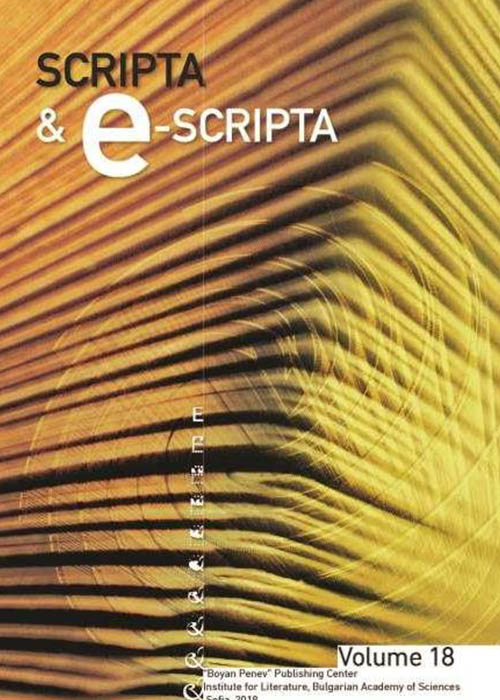The Last Judgment Scene in the Prophet Elijah Church (1550) in Sofia: Non-traditional Elements and Athonite Influences
Сцената Страшния съд в църквата „Св. пророк Илия“ (1550) в София: нетрадиционни елементи и атонски влияния

- Author(s): Ralitsa Rousseva
- Subject(s): Language and Literature Studies // Language studies // Studies of Literature // Philology // Theory of Literature //
-
Published by: Institute for Literature BAS

- Print ISSN: 1312-238X
- Summary/Abstract:
The composition of the Last Judgment in the church of Prophet Elijah (1550) in Iliyantsi (Sofia) was the first in Bulgaria in its new, thematically expanded model introduced by the Cretan school in the monasteries on Mount Athos and on the island in the Ioannina lake (1530s–1540s). Just several years later, the new elements such as the Dream of Daniel and the image of the poor man were included. The artist has not only transferred and interpreted the latest novelties for the 16th century, but has also added to and enriched the picture of the Last Judgment with unique images such as the personifications of the planets and the Zodiac, images of the prophets David and Solomon, the Heavenly Jerusalem and the conversation of the Theotokos with Archangel Michael in heaven. The image of an icon of Christ Pantokrator at the scales with sins also remains without a parallel and difficult to interpret. The numerous novelties in the iconography of the Iliyantsi church, introduced for the first time several years earlier on Mount Athos, may only be due to very active and direct relations between Sofia and Mt. Athos during the 16 th century.
Сцената Страшния съд в църквата „Св. пророк Илия“ (1550) в София:
нетрадиционни елементи и атонски влияния
Ралица Русева(Институт за изследване на изкуствата при БАН, София, България)
Композицията на Страшния съд в църквата „Св. Пророк Илия“ (1550) в Илиянци (София) за първи път в България представя нов, тематично разширен иконографски модел, въведен от Критската школа в манастирите на Света гора и на острова в Янинското езеро през 30-те – 40-те години на ХVІ в. Само няколко години след това в Илиянци се включват новите елементи като Сънят на пророк Даниил и образът на сиромаха. Зографът не само пренася и интерпретира последните нововъведения за XVI в., но прибавя и обогатява картината на Страшния съд с уникални образи като тези на персонификациите на планетите и зодиакалните знаци, образите на пророците Давид и Соломон, на Небесния Йерусалим и разговора на св. Богородица с архангел Михаил в Рая. Без паралел и трудно за разтълкуване остава изображението на икона на Христос Пантократор, поставена върху везните за измерване на греховете.
Стилово живописта върху фасадата на Илиянската църква може да се разглежда като отделен паметник от стенописите в наоса. В иконографско отношение обаче, цялостната програма на наоса също е белязана от последните нововъведения на Критската школа. Стенописите от 1550 г. в Илиянския манастир разгръщат широко поле за интерпретация, тъй като паметникът е „междинен“ – в него се наслагват две художествени тенденции: първата е свързана с живописта на Охридско-Костурския регион от ХІV–ХV век, а втората представя новите явления в балканската живопис от 30-те – 40-е години на ХVІ в., дело на представителите на Критската школа. Множеството нововъведения в иконографията в Илиянската църква, които за първи път са реализирани няколко години по-рано на Света гора, могат да се дължат само на много активни и директни връзки между София и Света гора.
Живописта от 1550 г. в Илиянската църква е основен средищен паметник между изкуството в светогорските манастири и по-късните паметници от Западна България и Северна Македония от края на ХVІ и началото на ХVІІ в.
Journal: Scripta & e-Scripta vol. 20, 2020
-
Page Range: 301-318
No. of Pages: 18
Language: English - LINK CEEOL:
-
Ralitsa RoussevaInstitute of Art Studies, Bulgarian Academy of SciencesDescription
Rousseva, Ralitsa, Assoc. Prof., PhD Institute of Art Studies, Bulgarian Academy of Sciences; Museum for Christian Art at the Crypt of St Alexander Nevski Cathedral, Sofia, Bulgaria
Ralitsa Svetlinova Rousseva is an Associate Professor at the Department of Old and Mediaeval Art in the Institute of Art Studies (Bulgarian Academy of Sciences) and Head of Department „Museum of Christian Art, Crypt of St Alexander Nevsky Cathedral“ (National Gallery). She has over 50 publications on the problematics of Byzantine and Post-Byzantine art. Some of her main topics are the Bulgarian art from 13th–14th century, monuments of Christian art in Albania, iconography of the Slavic saints. In her latest book Golden Book. Icons from Bulgaria (9th–19th century) are analyzed 100 icons, which traces the development of the icon painting in Bulgaria. She is a curator of the exposition in the Museum of Christian Art and the exhibitions: Icônes et manuscrits bulgares, Musées royaux d’Art et d’Histoire, Bruxelles 2002; Bulgarian Christian Art, State Historical Museum, Moscow 2003; curator of the Bulgarian part of the exhibition Byzantium. Faith and Power (1261–1557) at the Metropolitan Museum of Art, New York 2004; The Bulgarian Christian Art 13th–15th Centuries and the Palaeologan Renaissance. National Museum of History, Sofia 2006; Icons from Bulgaria 13th – 19th Centuries. State Historical Museum, Moscow 2009; The Rejoicing of Prayer. Unknown Icons from the Fund of Crypt. Museum of Christian Art, Crypt of St Alexander Nevsky Cathedral”, Sofia 2014 and many others.
-
SUBJECT: Language and Literature Studies // Language studies // Studies of Literature // Philology // Theory of Literature //KEYWORDS: Last Judgment // Iliyantsi monastery // Postbyzantine art // MOUNT ATHOS // Cretan school // Zodiac // Dream of Daniel //
-